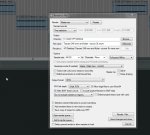Ok thanks. I want to make sure I understand everything before I proceed, so could you please elaborate on a few things?
Sorry about the late reply FB - was busy last night.
1. When you say you "pushed the roller harder onto the capstan," from where exactly did you push it? I assume you did this with the front cover still removed?
I just took off the inspection cover for the tape heads and pushed the metal roller housing on the edge facing towards the front of the machine- about halfway between the roller and the mounting post, of that makes sense? I also pushed the roller housing down a bit around the post and circlip.
2. When you say "checking the W&F with a proper tape every hour or so," do you mean using the same process described with the WFGUI program?
Yes - same prosess.
I tried the new version of WFGUI you sent me, and unfortunately it's not working for me either. I click on the "WAV" button, but as soon as I select a wave file to load, the program crashes on me. It did it three times in a row. Am I doing something wrong?
You mentioned earlier that you had to convert my file to mono and 44.1k, but it should have been that already. I rendered them as mono, and as far as I know, my Reaper program is set to 44.1k (although I need to verify this).
I used Audacity on a Windows 8 laptop which showed the file to be stereo 48k. I normalised the file to -15dB, removed the DC offset (at the same time) , converted to mono and used mix and render to convert to 44.1k then exported as wav. I checked this all again just now and got WFGUI to run ok. It is strange at the silent bits at the beginning and end but fine for the 10 secs or so the signal. Got same results as yesterday. If you still can't get it to run, post files here and I will check when I can.
3. I want to make sure I've installed the roller correctly. If you look at this picture of my roller (before it was reconditioned -- it looks brand new now), you can see how the little pin sticking through the roller is sticking up out of the top a little bit. It does not stick out through the bottom like this. In fact, it's not even really all the way flush with the bottom of that gold housing. It's just kind of pushed against the inside of the bottom lip. I couldn't push it through easily, and I didn't want to risk bending anything with pliers or anything, so I didn't push it. It seemed stable, so I just went ahead and installed it like that. But do you know whether or not that pin is supposed to be sticking all the way through both holes in that gold housing? And if so, how did you get it to do that?
I pushed mine down further into the bottom hole using a jeweller's tool - looks like a little screwdriver but has a circular end instead of a blade (ie the shaft is cylindrical all along) about the same diameter as the pin. You can get them at dimes stores I'm sure in sets with the little screwdrivers. I pit the roller housing over a block of wood with a hole in it and gently tapped the pin down. The top of the pin is almost flush with the top of the housing.
Thanks for the help!
PS Hope the comments are clear with the quote FB
Final thought - is the roller spinning free in the housing -- you should be able to get it to spin with your finger and for it to keep rolling a bit. I got a lot of W&F with the roller in my first 244 because it was a little tight in the housing - a slight tightness can make a hell of a lot of difference.
Hope this helps and you get it going - keep us posted!





